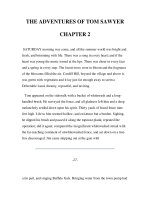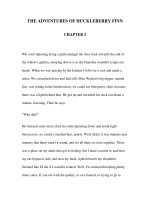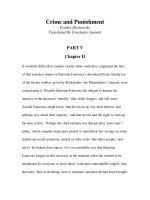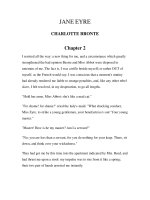Chapter 2 – sentence skills fragments, run ons, comma splices
Bạn đang xem bản rút gọn của tài liệu. Xem và tải ngay bản đầy đủ của tài liệu tại đây (900.46 KB, 15 trang )
Chapter 2 – Sentence Skills
Fragments, Run-Ons & Comma Splices
Fragments
Definition - A sentence fragment is an incomplete sentence.
Most fragments are missing the subject, the verb, or both.
Identifying some fragments can be confusing because they may actually contain a subject and a verb. However, these
nouns and verbs do not form an independent clause when they follow subordinating conjunctions, adverbs, or relative
pronouns.
Fragments
Example of a sentence fragment: After the party starts.
party= subject
starts= verb
This phrase has a noun and a verb; however, the subordinating conjunction ‘after’ makes it a dependent clause. Therefore, this dependent clause needs to be linked to an
independent clause.
Correct sentence: After the party starts, I will be able to relax.
(complex sentence)
‘I will be able to relax’ is an independent clause that can stand alone. It expresses a complete thought. Remember to separate a dependent clause and an independent
clause with a comma (when the dependent clause appears before the independent clause).
Fragments
/>
/>
Run-Ons
Definition - is when two or more independent clauses (i.e complete sentences) are joined without an
appropriate conjunction or mark of punctuation.
For example: It is nearly half past five we cannot reach town before dark.
Two types of run-on sentences are fused sentences and comma splices.
Run-Ons - Fused Sentence
Definition: A fused sentence consists of two independent clauses, but both the comma and coordinating conjunction are
missing.
Example of a Fused Sentence: She writes the music he plays the guitar.
‘She writes the music’and ‘he plays the guitar’are each independent clauses, containing a subject and a verb and expressing complete
thoughts.
‘He plays the guitar’ is an independent clause that can stand alone because it expresses a complete thought and is grammatically correct.
he=subject (S) plays=verb (V) guitar=direct object (DO)
However, in the above example, the independent clause, ‘She writes the music,’ incorrectly runs into a second independent clause, ‘he plays
the guitar.’
Run-Ons –
Strategies for Correcting Fused Sentences:
1. Create a compound sentence.
Inserting a coordinating conjunction (for, and, nor, but, or, yet, so) plus a comma correctly links these independent clauses. This sentence
structure is called a compound sentence.
Correct compound sentence: She writes the music, and he plays the guitar.
independent clause + comma + coordinating conjunction + independent clause
2. Separate independent clauses with periods and capitalization, creating simple sentences.
Correct sentence: She writes the music. He plays the guitar.
3. Insert a semi-colon.
Semi-colons should be used sparingly and to connect independent clauses whose meanings are closely related.
Correct sentence: She writes the music; he plays the guitar.
*Note: When more details are added to the above independent clauses, the meanings become much more closely related. Thus, a semi-colon can separate these clauses.
Run-Ons - Strategies for Correcting Fused Sentences:
4. Link ideas using a subordinate clause (dependent clause).
Correct Sentence: While she writes the music, he plays the guitar.
subordinate clause + comma + independent clause
‘While’ is a subordinating conjunction, which makes ‘while she writes music for Coldplay,’ a dependent clause. That is, the clause depends on the rest of the
sentence for the overall meaning to be clear. A dependent clause cannot stand alone. Use a comma to separate a dependent clause that appears before an
independent clause.
*Note: A sentence constructed of one independent clause and one or more dependent (or subordinate) clauses is called a complex sentence.
Comma Splices
Definition - A comma splice consists of two or more independent clauses that follow one another and are incorrectly linked together only with a
comma (or commas). The coordinating conjunction is missing.
Example of a Comma Splice: She writes the music, he plays the guitar.
In the above sentence, a comma separates the two independent clauses, but a coordinating conjunction is also necessary.
Strategies for Correcting Comma Splices:
1. Insert a coordinating conjunction to create a compound sentence.
Correct Sentences:
i)
She writes the music, but he plays the guitar.
ii)
She writes the music, and he plays the guitar.
Remember, the coordinating conjunction appears after the comma.
*Note: Again, consider meaning before joining sentences. If the sentences are not closely connected, it may be best to keep them separate.
Think about these two independent clauses: Today I was late for class. I will have a burrito for dinner tonight.
Since these ideas are distinct, keep the sentences separate.
Strategies for Correcting Comma Splices:
2. Insert a semi-colon.
Correct Sentence: She writes the music; he plays the guitar.
Again, to join two independent clauses with a semi-colon, be sure that their meanings are closely connected.
Chapter 4 - Example Exercise
Examples:
It was raining Naomi could not find her umbrella. (Fused)
It was raining, Naomi could not find her umbrella. (Comma Splice)
How to fix these run-ons:
Step 1: Identify the independent clauses.
It was raining + Naomi could not find her umbrella.
Step 2: Use one of the below strategies.
1.
Period + Capital Letter (Separate Sentences)
It was raining. Naomi could not find her umbrella.
S+V
Period
S +V
Chapter 4 - Example Exercise
2.
Comma + Coordinating Conjunction (Compound Sentence)
It was raining, and Naomi could not find her umbrella.
S+V
3.
, and
S+V
Semi-Colon
It was raining; Naomi could not find her umbrella.
S+V
4.
;
S+V
Subordinating Conjunction + Comma (Complex Sentence)
Though it was raining, Naomi could not find her umbrella.
dependent clause ,
S+V
Practice Exercises
1. I moved to the United States when I was young it was easy to learn English, my parents were already here, they knew English already.
2. John and David recognized each other they had been in the first grade together.
3. Her car would not start she was late for class.
4. The parents ate the baby slept in her stroller.
5. Roger wants to quit smoking this habit is too expensive.
(Refer to Answer Key document on Blackboard Week 6 if you’re having difficulty)
Practice Exercises
/>
/>
/>









